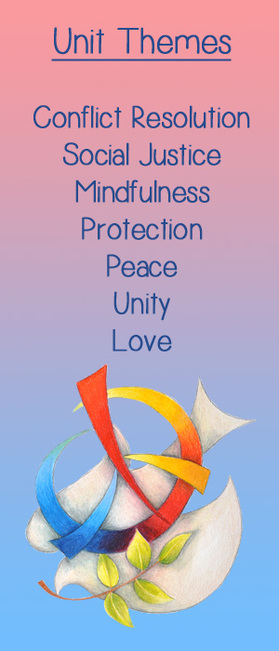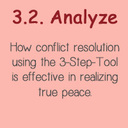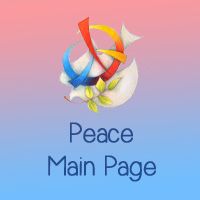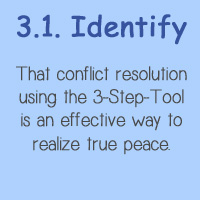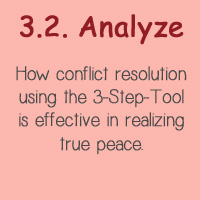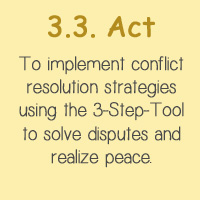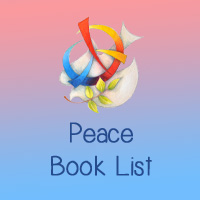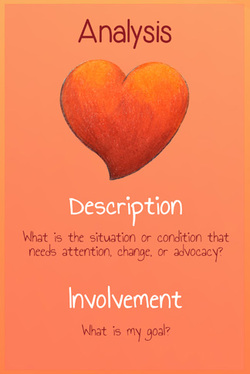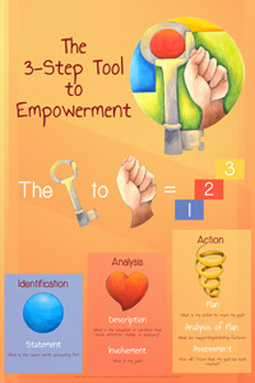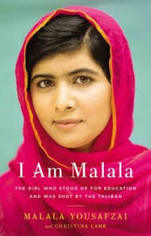Classroom Learning Activities
|
1. Analyze a Community's Need to for Peace
Students refer to the 3-Step-Tool to Empowerment to analyze a cause worth advocating for that relates to a community's obligation to protect every child and provide them with a life of peace. This includes the following process:
|
Values of respect for the right to peace guides the child when analyzing a cause and setting a goal worth advocating for.
|
2. Malala - Become a Peacemaker with her...
|
Book Summary:
At the age of 16, she has written for the BBC (under a pseudonym) describing her life in Swat valley, stood up for education at various protests, been nominated for the Nobel peace prize and been shot in the eye socket and neck by one of the worlds most dangerous extremist terrorist organisations, the Taliban. I Am Malala, written from Malala's point of view, is a beautifully written, brutally honest and heart-warming tale of a girl's innocence and will to make a positive difference, and how she was almost lost to the hands of a brutal and suppressive body who attempted, and still continue to threaten, to kill her. Malala has been described as a martyr for her cause countless times. She's been portrayed as the 'poor brave girl who got shot' or the 'girl who survived the Taliban shooting and spoke at the UN'. We're all so caught up in making Malala sound like a heroine, that we forget she's a teenager as well. We're so busy talking about how brilliantly she speaks and what a wonderful vision she has for the world, that we tend to not care about her friends and her encounters, and what she likes to do in her free time. She's outstandingly bold, and a true idol, but Malala lives in the real world. She is one of us. The way the book progresses is so powerful, it tends to hold on even after you've closed that perfect last page. Every child in the world must read this, or must have Malala's story read to them. For us readers, it may seem like a fairytale. Malala now lives in the UK with her family; they're safe and happy. But the revolution that she started still continues to shake the world, and especially Pakistan, with its impact. There's still a long way to go before the children of Swat valley can pick up a book and a pen, stand up for education and not have their lives in danger. |
|
Malala Yousafzai Addresses the United Nations - July 12, 2013
Unite with MalalaWe will continue our journey to our destination of peace and education.
No one can stop us! We will speak up for our rights and we will bring change to our voice. Our words can change the whole world because we are all together. Let us shield ourselves with unity and togetherness. Let us wage a global struggle against illiteracy, poverty, and terrorism. Let us pick up our books and our pens; they are our most powerful weapons. One child, one teacher, one book, and one pen can change the world. Education is the only solution; education first. (Yousafzai, 2013) |
Join Malala here and speak up for social justice, education, and peace for every child.
|
3. The Magic of Kindness
Orly Wahba is here to talk to us about the magic of kindness. As a middle-school teacher, she wanted to make a difference in the life of her students, so she designed “Act of Kindness” cards. These super-simple cards contained directions such as “open the door for someone” or “invite someone to have lunch with you,” along with an instruction to pass on the card once you were done. She wanted her kids to see the ripple effect of kindness. One day, some construction workers were outside her house. It was hot out, so she brought them drinks — and kindness cards. One of them got a card with the instruction “call your mother and father and tell them how much you love them.” He hadn’t seen his parents in 10 years; he approached her, incredulous. He just needed the prompt. Wahba shows us a film she put together to tell the story of the world we all live in. “Sometimes we just need to change our perspective.” And she tells us about Life Vest Inside, the organization she founded ”because kindness keeps the world afloat.” |
Orly Wahba has developed a curriculum that is intended to promote acts of loving-kindness in the classroom. To find out more about it, go here.
|
Relevant Convention Articles
Article 3
1. In all actions concerning children, whether undertaken by public or private social welfare institutions, courts of law, administrative authorities or legislative bodies, the best interests of the child shall be a primary consideration.
2. States Parties undertake to ensure the child such protection and care as is necessary for his or her well-being, taking into account the rights and duties of his or her parents, legal guardians, or other individuals legally responsible for him or her, and, to this end, shall take all appropriate legislative and administrative measures.
3. States Parties shall ensure that the institutions, services and facilities responsible for the care or protection of children shall conform with the standards established by competent authorities, particularly in the areas of safety, health, in the number and suitability of their staff, as well as competent supervision.
Article 6
1. States Parties recognize that every child has the inherent right to life.
2. States Parties shall ensure to the maximum extent possible the survival and development of the child.
Article 12
1. States Parties shall assure to the child who is capable of forming his or her own views the right to express those views freely in all matters affecting the child, the views of the child being given due weight in accordance with the age and maturity of the child.
2. For this purpose, the child shall in particular be provided the opportunity to be heard in any judicial and administrative proceedings affecting the child, either directly, or through a representative or an appropriate body, in a manner consistent with the procedural rules of national law.
Article 13
1. The child shall have the right to freedom of expression; this right shall include freedom to seek, receive and impart information and ideas of all kinds, regardless of frontiers, either orally, in writing or in print, in the form of art, or through any other media of the child's choice.
2. The exercise of this right may be subject to certain restrictions, but these shall only be such as are provided by law and are necessary:
(a) For respect of the rights or reputations of others; or
(b) For the protection of national security or of public order (ordre public), or of public health or morals.
Article 14
1. States Parties shall respect the right of the child to freedom of thought, conscience and religion.
2. States parties shall respect the rights and duties of the parents and, when applicable, legal guardians, to provide direction to the child in the exercise of his or her right in a manner consistent with the evolving capacities of the child.
3. Freedom to manifest one's religion or beliefs may be subject only to such limitations as are prescribed by law and are necessary to protect public safety, order, health or morals, or the fundamental rights and freedoms of others.
Article 15
1. States Parties recognize the rights of the child to freedom of association and to freedom of peaceful assembly.
2. No restrictions may be placed on the exercise of these rights other than those imposed in conformity with the law and which are necessary in a democratic society in the interests of national security or public safety, public order (ordre public), the protection of public health or morals or the protection of the rights and freedoms of others.
Article 38
1. States Parties undertake to respect and to ensure respect for rules of international humanitarian law applicable to them in armed conflicts which are relevant to the child.
2. States Parties shall take all feasible measures to ensure that persons who have not attained the age of fifteen years do not take a direct part in hostilities.
3. States Parties shall refrain from recruiting any person who has not attained the age of fifteen years into their armed forces. In recruiting among those persons who have attained the age of fifteen years but who have not attained the age of eighteen years, States Parties shall endeavour to give priority to those who are oldest.
4. In accordance with their obligations under international humanitarian law to protect the civilian population in armed conflicts, States Parties shall take all feasible measures to ensure protection and care of children who are affected by an armed conflict.
1. In all actions concerning children, whether undertaken by public or private social welfare institutions, courts of law, administrative authorities or legislative bodies, the best interests of the child shall be a primary consideration.
2. States Parties undertake to ensure the child such protection and care as is necessary for his or her well-being, taking into account the rights and duties of his or her parents, legal guardians, or other individuals legally responsible for him or her, and, to this end, shall take all appropriate legislative and administrative measures.
3. States Parties shall ensure that the institutions, services and facilities responsible for the care or protection of children shall conform with the standards established by competent authorities, particularly in the areas of safety, health, in the number and suitability of their staff, as well as competent supervision.
Article 6
1. States Parties recognize that every child has the inherent right to life.
2. States Parties shall ensure to the maximum extent possible the survival and development of the child.
Article 12
1. States Parties shall assure to the child who is capable of forming his or her own views the right to express those views freely in all matters affecting the child, the views of the child being given due weight in accordance with the age and maturity of the child.
2. For this purpose, the child shall in particular be provided the opportunity to be heard in any judicial and administrative proceedings affecting the child, either directly, or through a representative or an appropriate body, in a manner consistent with the procedural rules of national law.
Article 13
1. The child shall have the right to freedom of expression; this right shall include freedom to seek, receive and impart information and ideas of all kinds, regardless of frontiers, either orally, in writing or in print, in the form of art, or through any other media of the child's choice.
2. The exercise of this right may be subject to certain restrictions, but these shall only be such as are provided by law and are necessary:
(a) For respect of the rights or reputations of others; or
(b) For the protection of national security or of public order (ordre public), or of public health or morals.
Article 14
1. States Parties shall respect the right of the child to freedom of thought, conscience and religion.
2. States parties shall respect the rights and duties of the parents and, when applicable, legal guardians, to provide direction to the child in the exercise of his or her right in a manner consistent with the evolving capacities of the child.
3. Freedom to manifest one's religion or beliefs may be subject only to such limitations as are prescribed by law and are necessary to protect public safety, order, health or morals, or the fundamental rights and freedoms of others.
Article 15
1. States Parties recognize the rights of the child to freedom of association and to freedom of peaceful assembly.
2. No restrictions may be placed on the exercise of these rights other than those imposed in conformity with the law and which are necessary in a democratic society in the interests of national security or public safety, public order (ordre public), the protection of public health or morals or the protection of the rights and freedoms of others.
Article 38
1. States Parties undertake to respect and to ensure respect for rules of international humanitarian law applicable to them in armed conflicts which are relevant to the child.
2. States Parties shall take all feasible measures to ensure that persons who have not attained the age of fifteen years do not take a direct part in hostilities.
3. States Parties shall refrain from recruiting any person who has not attained the age of fifteen years into their armed forces. In recruiting among those persons who have attained the age of fifteen years but who have not attained the age of eighteen years, States Parties shall endeavour to give priority to those who are oldest.
4. In accordance with their obligations under international humanitarian law to protect the civilian population in armed conflicts, States Parties shall take all feasible measures to ensure protection and care of children who are affected by an armed conflict.
Online Resources and References
- 6 Elements of Social Justice Education - Children's Literature annotated list for the elementary classroom.
- Art Educators - Teaching Ideas of Social Injustice Using Children's Literature by Sarah Ryder.
- British Columbia Ministry of Education - Teaching for Diversity and Social Justice Throughout the K-12 Curriculum: Making Space.
- Equitas - Educate. Empower. Change. - Advancing the equality, social justice, and respect for human dignity in Canada and around the world through education.
- Hooker, Karen E. & Fodor, Iris E. (2008). Teaching Mindfulness to Children. Gestalt Review, 12(1): 75-91. Retrieved from: http://www.mindfuleducation.org/mindfulnessforchildren.pdf
- It's Pronounced Metrosexual - A fantastic site on social injustice, sexuality, and gender issues.
- Malala Fund - Join Malala
- Life Vest Inside - Empowering people to engage in acts of love and kindness
- Oyler, Celia. (2011). Preparing teachers of young children to be social justice-oriented educators. Promoting Social Justice for Young Children. Retrieved from: http://www.academia.edu/1168846/Preparing_teachers_of_young_children_to_be_social_justice-oriented_educators
- Picower, Bree. (2012). Using Their Words: Six Elements of Social Justice Curriculum Design for the Elementary Classroom. International Journal of Multicultural Education. 14(1). Retrieved from: http://www.ijme-journal.org/index.php/ijme/article/view/484/677.
- Planting Seeds: Practicing Mindfulness with Children - the Plum Village Community Collective.
- Planting Seeds: Practicing Mindfulness with Children - Peace Treaty.
- Schmidt, Laurel. (2009). Stirring Up Justice. Teaching Social Responsibility. 66(8) 32-37. Retrieved from: http://www.ascd.org/publications/educational-leadership/may09/vol66/num08/Stirring-Up-Justice.aspx
